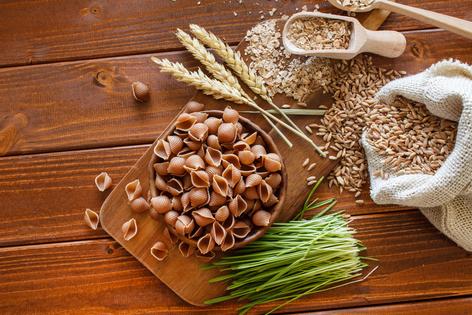Environmental Nutrition: Fight cancer with fiber
Fitting fiber into your diet is a cancer-preventive strategy. Fiber most clearly protects against colorectal cancer (risk drops 10 percent for each 10-gram increase in fiber). Analysis combining 16 population studies also links higher fiber with lower breast cancer risk. Because fiber is a component of foods with nutrients and plant compounds (phytochemicals) that may help reduce cancer risk, it's difficult to isolate fiber-specific protection.
Fiber's multi-tasking protection
Dietary fiber may work in multiple ways to protect against cancer:
--Reduces intestinal exposure to toxins, dilutes concentration and speeds passage through the gut.
--Feeds healthy bacteria in your intestines that ferment fiber, forming substances that seem to promote colon cell health and fight inflammation as they circulate throughout the body.
--Lowers body estrogen levels by binding it in the colon, thus decreasing risk of estrogen-sensitive cancers.
--Reduces unhealthful levels of insulin, a hormone that seems to promote development of several types of cancer.
--Is linked with lower body weight and less tendency to gain weight, though fiber's specific role is controversial. Since overweight and obesity increase the risks of nine forms of cancer, this link has important cancer prevention potential.
Fiber's many forms
Dietary fiber refers to fiber that is naturally present in plant foods. Functional fiber is isolated fiber that is added to foods or used as a supplement. Functional fiber's effects are real, but studies linking lower cancer risk with higher dietary fiber intake may partly reflect benefits of other nutrients and compounds in whole plant foods. Fiber is not all the same, and sources differ in the health benefits they offer. Here's a rundown on different fiber types:
Traditionally, fiber was classified as soluble (linked with lower blood cholesterol) or insoluble (linked with better intestinal regularity). While these terms are still seen in some studies, each includes types of fiber that act quite differently.
Viscous fiber is gel-forming in the intestines; fermentable fiber is the type that gut bacteria can ferment.
Resistant starch -- a significant portion of the starch in dried beans -- has traditionally not been counted as dietary fiber, yet it also is fermented by gut bacteria.
Fiber sources and types overlap. Soluble fiber can be fermentable, viscous or both. Insoluble fiber may or may not be fermentable. The same food, whether apples, dried beans or oatmeal, contains several types of fiber. So, get your fiber from a wide variety of sources to gain the full array of potential health benefits.
Fiber-boosting strategies
The best strategy is to meet or exceed fiber recommendations through a variety of naturally high-fiber foods so you get all types of fiber and the bevy of nutrients that accompany them. Expand your high-fiber choices from these categories daily:
Grains: Each 1/2 cup (or 1-ounce) serving of whole grains provides 2 to 4 g of dietary fiber; some with added bran provide 5 to 10 g.
--Grain products, including pita bread and sandwich wraps, labeled "contains whole grains" are better than refined grains, but not as good as "100 percent whole grain."
--If switching to a high-fiber cereal is challenging, mix it with your usual lower-fiber choice as you transition.
--Broaden your selection of cooked grains for side dishes or ingredients: try brown rice (including quick-cooking), whole wheat couscous, bulgur, barley, quinoa, farro and freekeh. Whole wheat pasta is especially good with a flavorful sauce.
Vegetables: Each 1/2 cup (cooked or raw) usually provides 2 to 4 g of dietary fiber, although a 1-cup serving of raw lettuce has less than 1 g.
--Double the vegetables in casseroles, stews and stir-fries.
--Add raw, cooked or frozen vegetables (or leftovers) to homemade or prepared soups.
--Use vegetables, such as bell pepper strips or broccoli florets, for dipping with hummus and other dips.
Legumes: Dried beans (including soyfoods like tofu, tempeh and edamame), peas and lentils are concentrated sources of fiber, with 6 to 8 g per half-cup (cooked.)
--Swap legumes for half the meat or poultry in casseroles or stir-fries.
--Add canned beans to salads, pasta sauces or burritos.
--Use lentils in pasta sauce or soup; they cook quickly without presoaking.
--Thicken soups with pureed beans instead of cream or flour.
Fruits: Most provide 2 to 3 g of fiber in 1/2 cup or 1 medium piece (though some, like berries and pears provide at least 4 g.)
--Add fresh or dried fruit to your cereal. Especially with oatmeal or other cooked cereal, frozen options make berries and peaches budget-friendly toppings year-round.
--Use fruit instead of jelly in a sandwich.
--Add fresh or frozen fruit to plain yogurt instead of choosing fruit-flavored yogurts with minimal fruit content.
Nuts and seeds: A 1.5-ounce serving of most nuts and seeds provides about 3 g of fiber.
--Top salads and mixed dishes with nuts instead of croutons or breadcrumbs.
--Add a couple tablespoons of flaxseed to cereal; grind in a coffee grinder to get absorbable nutrients with the fiber boost.
(Environmental Nutrition is the award-winning independent newsletter written by nutrition experts dedicated to providing readers up-to-date, accurate information about health and nutrition in clear, concise English. For more information, visit www.environmentalnutrition.com.)







